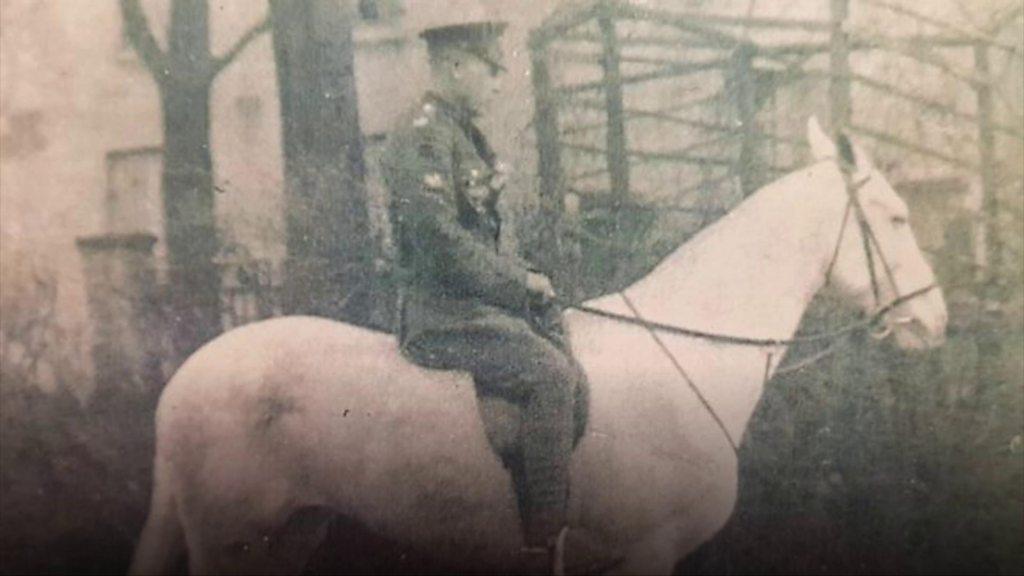WW1: From GAA pitch to the Western Front
- Published
The GAA players who enlisted in WW1
The bravery of soldiers from both parts of Ireland who fought and died in World War One has been widely commemorated.
However, one group of men who enlisted have remained largely hidden.
With its ban on members of the crown forces, the GAA would seem like an unlikely source of recruits for the 1914-1918 war.
However, historian Dr Dónal McAnallen insists that's just not the case.
He and fellow historian Jonathan Gray have been researching the subject and on Monday night gave a talk about Tyrone GAA members who fought in World War One.
"I've got about 65 names of individuals who signed up for the war from GAA membership in Ulster," said Dr McAnallen at Tyrone GAA headquarters in Garvaghey.
"That is not representative of the entire figure, for example there's one club in west Belfast where 20 members enlisted - St Peter's - and in another club in west Belfast, O'Neill Crowleys, seven members had died by 1917.
"You're certainly talking about well into three figures the number of GAA members who fought in the war.
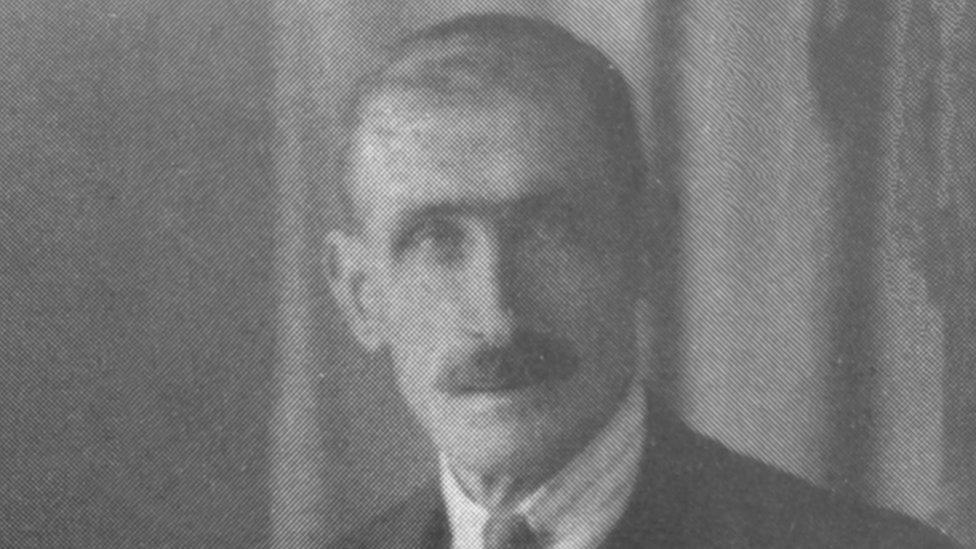
Alex Donnelly was 47 and a father of five when he enlisted
"But you can't always find their names, because these were not men of high rank, they didn't go to university for the most part, they didn't rise up through the ranks of the army.
"Some of them died and didn't have any family living after them, then of course there was the reticence of the nationalist community to commemorate."
Killed in action
Among them were at least a dozen Tyrone GAA members, such as three men from the Brian Óg club in Cookstown - Patrick Cory, Robert Lawless and Louis Boyle.
Mr Cory, who joined the Royal Inniskilling Fusiliers, was killed by shell fire at Bethune in July 1915; Robert Lawless, a member of the same regiment, was killed at Festubert in the same year.
Louis Boyle, also from the Cookstown club, joined the Canadian Infantry and was killed at the Somme in 1916.
Another one-time member of the club, Alex Donnelly, joined the Royal Engineers in 1917 as a 47-year-old father of five. He returned from the war and later worked as a groundsman at Corrigan Park in Belfast.
Then there are three friends from Coalisland, members of the Coalisland Fianna club - Tommy Bradley, John Patrick Daly and Patrick Gartland.
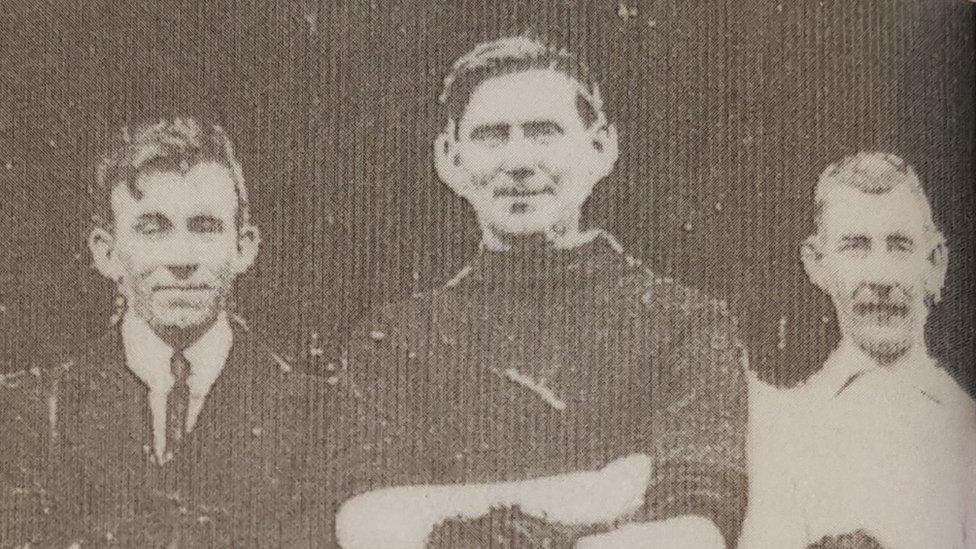
Dan Hegarty (middle) survived bronchitis and being shot in the leg to return to play for a championship winning Moy team in 1920
"They all enlisted in the Royal Field Artillery in Athlone in November 1914 - you can see in the enlistment records their names are pretty much consecutive," Dr McAnallen said.
"Each saw action. Bradley and Daly came back and each played Gaelic games for Coalisland in the 1920s - Daly emigrated to New York in 1928.
"Both had played for Tyrone in 1913, Bradley actually made a Tyrone return in 1925, 12 years after and refereed two county football championships.
"Patrick Gartland was killed in action in France in October 1918, just before the end of the war. So two came back and one died."
'Ambition to fly'
Another GAA player who fought on the Western Front was former RIC man Dan Hegarty, who joined the Irish Guards and survived bronchitis and being shot in the leg to return to play for a championship winning Moy team in 1920.
Two late recruits into into British forces were Dungannon men Patrick Holland and John Anthony Mooney.
"Patrick Holland was, quite amazingly, secretary of the Tyrone County Board," Dr McAnallen said.
"They decided to go and join the RAF towards the end of the war.
"They didn't really see much by way of action - it seems like the ambition to fly was maybe the primary instinct, rather than necessarily fighting the war, if you wanted to fly there weren't many other options."
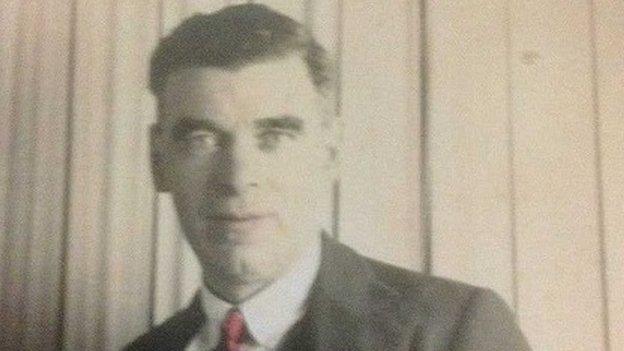
Patrick Holland was secretary of the Tyrone County Board when he joined the RAF late in the war
Mr Holland later moved to Scotland before emigrating to Australia and Dr McAnallen said that while many of those GAA members who fought returned to their local areas, many did not stay there long.
"Maybe they felt slightly displaced by the whole experience, because they weren't really being treated as war heroes. It's not necessarily that they were being shunned, maybe what they came back to was not what they expected.
"I think it probably depends on the community you came back to.
"I think if you were a very able player and you came back and you maybe had a brother in the team or something like that, it probably would have been an easier return. Some of them would have been injured and not able to return.
"Another aspect was that there were a lot of sectarian tensions in the 1920s and maybe somebody's war record was not foremost in people's thoughts, there was other stuff going on.
"The one thing that wasn't done was there was no community celebration or official commemoration of their participation in the war."
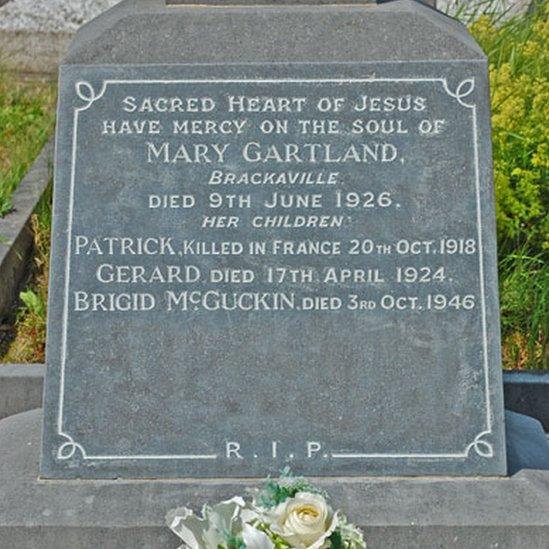
Of three friends from the Coalisland Fianna club, two returned, but Patrick Gartland was killed near the end of the war
Dr McAnallen said while the research could sometimes be frustrating in terms of establishing exact numbers of GAA members who enlisted in World War One, the human stories that emerged were rewarding.
"You do get a far clearer idea of the human reality of their lives before, during and after the war and what may have inspired them to have enlisted," he said.
"Maybe they had a brother out there already, maybe it was employment conditions, maybe they were working long hours in the mill and they just wanted out of it, maybe it was an escape - the chance to see another country.
"Maybe they just didn't know what they were getting themselves involved in."
The Cardinal O Fiaich Library project 'Forgotten Gaelic Volunteers' is supported by the Heritage Lottery Fund.
- Published6 November 2018
